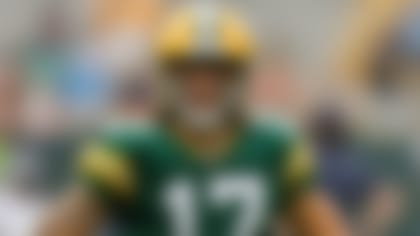With all apologies to Bill Parcells and the old school coaching fraternity, the NFL has become an offensive game. All you have to do is look at last year's Super Bowl, where the league's best offense ran over the league's best defense.
The current NFL rules have been built to breed offensive success. That fact, combined with a greater crop of extraordinary college athletes joining the pro ranks, has yielded some explosive offensive units in recent seasons. Plus, for whatever reason, colleges are developing more guys who can throw and catch, more linemen who can pass protect, and more tight ends that look like NBA forwards. This is the new NFL and the old school is going to need to accept it and come to terms with how to deal with it.
The latest incarnation of offensive wizardry is the spread offense that uses the pass to set up the run, or sometimes not. The Seahawks have had a lot of recent success with QB Matt Hasselbeck spreading the field and distributing the ball to a variety of receiving targets. The Saints have gone to a similar style of play since the injury to Deuce McAllister. The Colts obviously have had great success with their three receiver sets and their use of tight end Dallas Clark, but the Patriots have taken it to a new level. New England currently leads the NFL in total offense (425 yards per game) and scoring (38.7 points per game), more than 35 yards and six points per game better than the second most prolific unit (Dallas). The scariest stat of all is the fact they score a touchdown close to 70 percent of the time they start a series more than 80 yards away from the goal line. The NFL average for such a feat is 14 percent success rate.
Their base set includes three receivers to the left of the formation and two to the right with QB Tom Brady in the shotgun in an empty backfield. The theory is that the defense can't get to the quarterback before he can throw. Five blockers on the offensive line pick up the five closest threats, and the sixth pass rusher is likely coming off the edge in the form of an outside linebacker or a safety. That player has a long way to go to get to the passer, and when he does blitz, the slot receiver on his side will run an option route to get open on a quick-hitting pass.
Wes Welker, who is the ideal receiver for the slot in this system, had another big game last week against the Steelers. In one sequence, the Patriots started with the ball on their own 1-yard line and proceeded to throw six consecutive passes to Welker in the slot. No matter what coverage or blitz scheme the Steelers played, they could not stop the play. That's because the read-and-react nature of the offense essentially puts the defense in the wrong spot every time. If the defender plays an inside technique, the slot receiver runs a pivot route out towards the sideline. If the defender is outside, the slot runs a quick slant to the inside. The receiver can't be wrong in any situation.
Receivers are the key to the game today. We are now in the era of the forward pass, wide open sets, and empty backfields. The question opposing offensive coordinators have to ask themselves is, "Can I afford to run?" A traditional offense with a run-first mentality doesn't score fast enough, and if they don't score, they punt the ball away knowing that the spread is likely going to put them in a two-score hole before they see the ball again. Expect to see more and more of the spread over the course of the next few seasons.
The other side of the ball
So the best offensive teams like the Patriots, Cowboys, Colts, and Packers are all throwing the ball. How do you stop them? You need a defense that can rush the passer and man up and cover on the corners. If a defensive unit doesn't have at least one matchup cornerback to cover a team's best receiver, and at least two consistently effective pass rushers, they will struggle.
With the big four - New England, Dallas, Indianapolis, and Green Bay, listed above all set for the playoffs, let's see what teams have the personnel to be competitive in the postseason. The Pats have Mike Vrabel and Richard Seymour as pass rushers and Asante Samuel on the corner. Check. The Cowboys feature pass rushers DeMarcus Ware and Greg Ellis and an improved cover corner in Terence Newman. They fit the bill. The Packers attack the quarterback with Aaron Kampman and Kabeer Gbaja-Biamila, and have two of the top corners in the game in Charles Woodson and Al Harris, another good fit. The Colts however, will miss the pass-rush presence of Dwight Freeney, and Robert Mathis is having knee trouble. They don't quite fit the bill.
The next four teams in the AFC are the Steelers, Jaguars, Chargers, and Browns. The Steelers have lost DE Aaron Smith and are not particularly strong at the corners. The Jaguars feature CB Rashean Mathis, but haven't rushed the passer with any consistency this season. The Browns don't have a pass rusher beyond Kamerion Wimbley and are extremely suspect in the secondary. But the Chargers have two excellent pass rushers in Shaun Phillips and Shawne Merriman, and have playmaking corners in Quentin Jammer and Antonio Cromartie. They could make a run in the playoffs.
In the NFC, Seattle has to be considered a threat with a pass rush (second in the league with 41 team sacks) led by DE Patrick Kerney and CB Marcus Trufant, who is coming off a three interception game against Arizona. The Giants have the best pass rush in the league, but do not have a shut-down corner. Tampa has a front four with a lot of speed that creates upfield pressure, but its corners are aging and headed towards the end of their careers. Finally, the Vikings have sparked their turnaround with a slew of takeaways, but do not rush the passer well.
Offense will definitely be the theme of this year's playoffs. But a team with the right defensive personnel could make a surprising run if they are hot at the right time. As one prominent defensive-minded head coach said, "It might take 12 guys to beat the Patriots."




